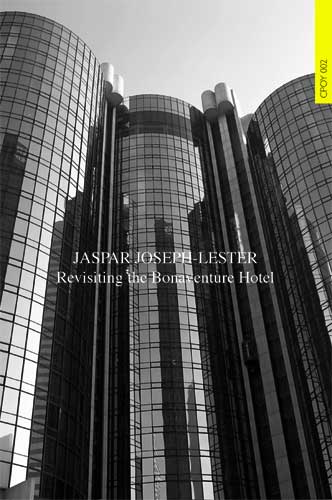< Back to Works / < Back to Publications
Revisiting the Bonaventure Hotel

Revisiting the Bonaventure Hotel is a photo-essay that describes the life of a building through a range of film stills, photographic images and written citations. Here we wander between references to Fredric Jameson, John Portman and Arnold Schwarzenegger and view the world through different perspectives: vertical, horizontal and rotating. This is a story about the image.
'What's seen by the eye, what's held by the hand, or stepped on underfoot, what passes through the mind, or through the wallet, when one meets the Bonaventure - do these ever connect? It's not always clear what, if anything, makes up the permanence of this object, this 'residence' (re-sidere, 'sit again') of the Bonaventure. It is not clear what underwrites the Bonaventure's continuity in time, what binds its many different points: on the ground, in film, in the mind. The thing called the Bonaventure (perhaps like any other thing - but that is a much more general problem), is only held together - some would say - by a name, or by the act of naming. There's no need for philosophy here. All we need do, for example, is walk through the front door, or the hotel's webpage (its virtual doorstep). The Westin Bonaventure's site says very little, indeed nothing at all, of critical thought, of art, of history, or even of popular film. The images that flash before us online are of neatly set interiors, beds made perfect, white napkins fanned out in a glass, soft furnishings, mostly. There are, of course, plates on the wall commemorating well-loved moments in film, there are still images from the movies on some of the walls. In other words, the Bonaventure's domains do sometimes connect. But they never truly seem to come together as one, even as the Bonaventure stays in its place as a permanent fixture.
It is, perhaps, not an unusual state of affairs, but it's perplexing, none the less. 'The world - not only ours - is fragmented. Yet it does not fall to pieces', says Cornelius Castoriadis. And, he adds, 'To reflect upon this situation seems to me to be one of the primary tasks of philosophy today.' But philosophy is not enough. The Bonaventure is the site of more than thoughts (What would the managers, executives, lovers, patrons, cleaning staff and tourists say if they heard us saying this?). The Bonaventure is deeply wound up in its images. Revisiting those images is to 'revisit' the Bonaventure which, let us now allow, is not just a hotel, but rather an object, a permanent fixture made of disparate parts. What is that object, this site of meaning? That is precisely what Jaspar Joseph-Lester helps us see. What's wonderful is that through this helping-to-see we also get to explore some much more fundamental questions about the process of seeing itself. Such exploration, one could readily argue, is the core business of art...'
Ahuvia Kahane